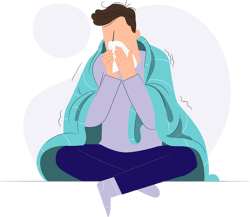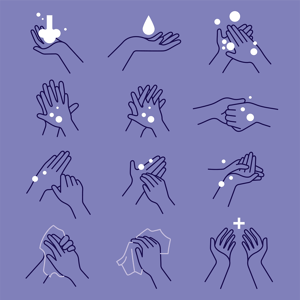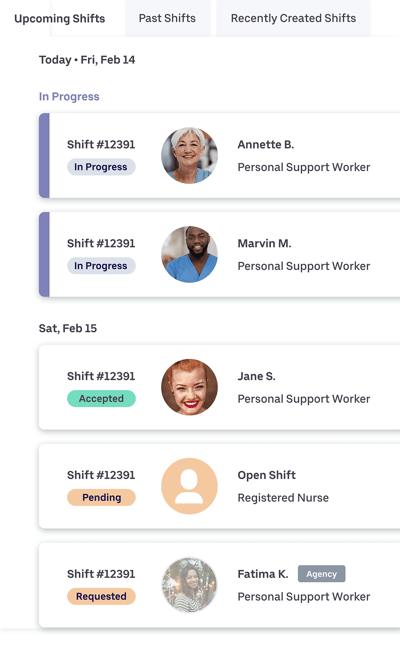
Getting ready for flu season demands a two-pronged approach. Your first line of defense is preventative. Help employees stay healthy so they are less likely to contract illness and spread it to patients and residents, many of whom are at higher risk of developing complications. Then, you need a backup plan in place so you never face staff shortages even if employees fall ill. Here’s what to do to keep your care facility delivering high quality care throughout the flu season and ongoing pandemic.
Help Employees Stay Healthy
Proper handwashing and hygiene: Infection control seems simple, but it’s the best way to stop spreading the viruses that cause seasonal flu. Send reminders about frequent handwashing and put posters up that demonstrate proper handwashing technique. Set up hand sanitizing stations at entrances and in busy areas and provide face masks. Encourage staff, residents and visitors not to touch their noses and mouths, to sneeze into their elbows and to greet each other with elbow bumps instead of shaking hands.
Proper PPE: Provide staff with standard Personal Protective Equipment (PPE), including gloves, face masks and gowns. If patients or residents are infectious – particularly if they have cough or are sneezing – make every effort to isolate them, or else take droplet precautions by providing them with face masks.
Equipment (PPE), including gloves, face masks and gowns. If patients or residents are infectious – particularly if they have cough or are sneezing – make every effort to isolate them, or else take droplet precautions by providing them with face masks.
Employee Wellness: To avoid burnout and stress, it's important for staff to keep regular hours, have adequate breaks and not be overworked. Encourage good eating habits by providing adequate breaks. Rest and good nutrition helps boost the immune system, keeping employees healthy, alert and less vulnerable to contracting illness.
Clear Messaging About Illness: Some staff come to work when they’re under the weather because they feel they’re expected to, or they can’t afford to lose the hours. Make it clear to all staff that they should stay home if they are sick so they don’t put others at risk. Employees who have been off work with the flu should not return to work until at least 24 hours after their temperature has returned to normal. Make sure staff and visitors are pre-screened for symptoms of COVID-19 and seasonal flu before entering any facility.
Vaccinations: This year, with the rise of the contagious Delta coronavirus variant, it’s crucial that healthcare employees be fully vaccinated against COVID-19 (e.g. with two doses of any approved vaccine, e.g. Pfizer, Moderna, AstraZeneca). As the fall approaches, it's also important that employees and long-term residents be vaccinated against seasonal flu. While many healthcare organizations have mandated their staff be vaccinated for COVID-19, those that haven’t should provide vaccination access for employees, offer education if they are experiencing vaccine hesitancy, and monitor for compliance with vaccination protocols.
vaccinated against seasonal flu. While many healthcare organizations have mandated their staff be vaccinated for COVID-19, those that haven’t should provide vaccination access for employees, offer education if they are experiencing vaccine hesitancy, and monitor for compliance with vaccination protocols.
Prepare for Locum (Fill-In) Staff
Regardless how prepared you are, staff shortages are a reality for the fall and winter months and healthcare facilities must have backup plans in place. Many call on part-time or casual staff to fill in or acquire so-called “locum tenens” (replacement) staff through a partnership with an agency or service like the BookJane Care Network.
The BookJane Care Network, currently available in parts of Ontario and accessed through the BookJane app, is the perfect place to find immediate replacements when staff members call in sick. When there’s a last-minute cancellation, BookJane's seniority based call-out feature automatically sends that shift to the staff with highest seniority. The call-out is repeated to the rest of the team in order of seniority until the shift is filled. BookJane frees administrative staff from long hours spent poring over unwieldy and error-prone spreadsheet timetables and on the phone with staff members to get confirmations. Four out of ten employees reportedly lose 25% of their work weeks to these kinds of automatable tasks. Most importantly, having a dependable service ready to provide qualified replacements ensures that facilities never go understaffed.
team in order of seniority until the shift is filled. BookJane frees administrative staff from long hours spent poring over unwieldy and error-prone spreadsheet timetables and on the phone with staff members to get confirmations. Four out of ten employees reportedly lose 25% of their work weeks to these kinds of automatable tasks. Most importantly, having a dependable service ready to provide qualified replacements ensures that facilities never go understaffed.
It’s important for healthcare professionals to stay healthy and safe at the best of times. During a pandemic, when viral spread is more rapid and illness more severe, it’s even more important that they stay strong and able to do their jobs. Healthcare professionals have been heroes throughout the pandemic and facilities need to their part to protect essential workers as we enter flu season on top of the challenges of COVID-19.
For more insights from BookJane on supporting employees and fostering a healthy work environment, visit our blog: https://www.bookjane.com/blog





